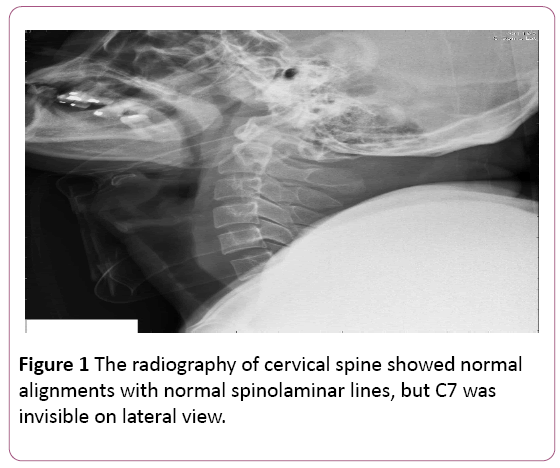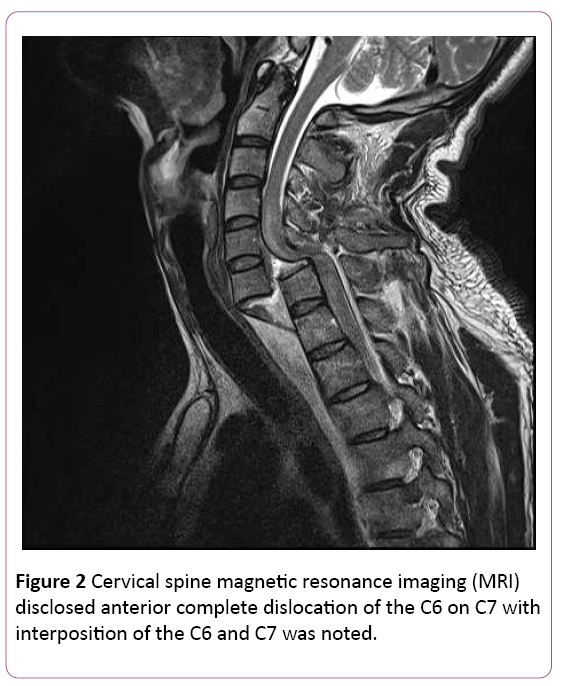ISSN : 2576-3938
Journal of Emergency and Internal Medicine
An Easily-Missed Case of Severely Injured Cervical Dislocation
Tzu-Liang Hsu1 and Chien-Ming Chao2*
1Department of Orthopedic Surgery, Tungs' Taichung MetroHarbor Hospital, Wuchi Main Campus, Taichung, Taiwan
2Department of Intensive Care Medicine, Chi Mei Medical Center, Liouying, Tainan, Taiwan
- *Corresponding Author:
- Chien-Ming Chao
Department of Intensive Care Medicine
Chi Mei Medical Center
Liouying, Tainan, Taiwan
Tel: (06) 251-7623; +886 4 2662 6161
E-mail: ccm870958@yahoo.com.tw
Received Date: August 26, 2017; Accepted Date: August 30, 2017; Published Date: August 31, 2017
Citation: Chao CM, Hsu TL (2017) An Easily-Missed Case of Severely Injured Cervical Dislocation. J Emerg Intern Med Vol.1, No1:09.
Abstract
A 41-year-old man presented with neck soreness and limbs weakness after a fall from 6 meters height when he was climbing tree for collecting the nectar and turned it into honey. He was brought to our emergency department for help. He had no initial loss of consciousness, vomiting and nausea. His Glasgow coma scale was also full but his muscle power of all limbs was 2 degree. Neck collar was placed immediately. He had the past history of panic disorder. The results of laboratory examinations were normal except elevated myoglobin, creatinine, and potassium.
A 41-year-old man presented with neck soreness and limbs weakness after a fall from 6 meters height when he was climbing tree for collecting the nectar and turned it into honey. He was brought to our emergency department for help. He had no initial loss of consciousness, vomiting and nausea. His Glasgow coma scale was also full but his muscle power of all limbs was 2 degree. Neck collar was placed immediately. He had the past history of panic disorder. The results of laboratory examinations were normal except elevated myoglobin, creatinine, and potassium. The radiography of cervical spine showed normal alignments with normal spinolaminar lines, but C7 was invisible on lateral view (Figure 1). Two hours later, he complained of paraplegia so urgent cervical and thoracolumbar magnetic resonance imaging (MRI) were performed and disclosed anterior complete dislocation of the C6 on C7 with interposition of the C6 and C7 was noted (Figure 2). He received surgical intervention of C6~C7 cervical disectomy with cage fusion and fixation with plate and physical rehabilitation with a regular exercise program. He was discharged 16 days later and sustained paraplegia sequelae.
Delayed diagnosis of cervical spine injuries can be caused by misinterpretation of radiographs, and incomplete or inadequate cervical spine series. In patients with obvious symptoms or trauma history, cervical spine precaution should be maintained until evaluation of patients is completed and radiographs have been interpreted by skilled reviewers. Patients with altered mental status should also remain in cervical spine precautions until they are awake to complete evaluation. Further radiologic examination using cervical CT scan becomes necessary when indicated by the cervical spine series or by clinical doubtfulness.
Open Access Journals
- Aquaculture & Veterinary Science
- Chemistry & Chemical Sciences
- Clinical Sciences
- Engineering
- General Science
- Genetics & Molecular Biology
- Health Care & Nursing
- Immunology & Microbiology
- Materials Science
- Mathematics & Physics
- Medical Sciences
- Neurology & Psychiatry
- Oncology & Cancer Science
- Pharmaceutical Sciences


